The iPad as an Affordable Communicator: Initial Review
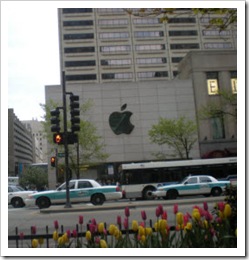
While in Chicago, I made a short trek to the Apple Store. My mission was to try out an iPad, which are still unable here in Canada until May 28th, to see if I could reliably use the touch screen with my shaky athetoid cerebral palsy. The reason for wanting an iPad is to use it as a communication device while I’m out and about.
I spent an hour playing with the thing, not quite sure what I was doing. Although I did manage to get a tweet out with minimal typos:

Once I had had enough playing, I attracted the attention of the young Apple employee Courtney and indicated that I was ready to buy one. She said they were sold out. My heart sank. Then she found one in the back room, and when an employee looked surprised, she said that one was special. (I sensed a shipment had just arrived, but had yet to be inventoried.)
Courtney spent a good hour with me, activating the device and then setting up an iTunes account to download the Prologuo2Go appp. I was impressed by the time she spent with me, as well as how she treated me. Thanks Courtney!
In the end, I purchased the iPad 32G WiFi, iPad case and the protection plan (I usually don’t buy them, but just in case) for $802.40 USD (including tax) and $215 in iTunes gift cards for the app (there was glitch with me being from Canada and purchasing gift cards to buy the app was the work around). In theory, I now had a communication device plus much more for $1,217.40 USD. That’s what credit cards are for, right?!
I left the Apple Store completely amazed by Courtney’s service, but not totally convinced I had made the right decision with purchasing the iPad.
I then headed back to the the hotel where I was meeting my friends Karen and Amy, one of which is Deaf and the other is hearing impaired. I only had a brief time with my iPad before putting it to the test as a communication device. But, that was long enough!
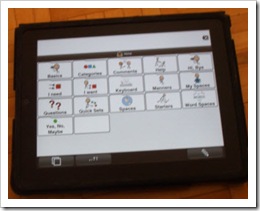 I discovered the Proloquo2Go app also has keyboard, as well as the predefined categories and phrases, which will take some learning and memories where specific words are. The neat thing is phrases can be added and customized, which may prove useful over time – once I get to add them.
I discovered the Proloquo2Go app also has keyboard, as well as the predefined categories and phrases, which will take some learning and memories where specific words are. The neat thing is phrases can be added and customized, which may prove useful over time – once I get to add them.
But, the keyboard proved the most useful. When I’m communicating with people, they typically get stuck on a word or two. With the onscreen keyboard, I can type out the words – like I did with the low-tech alphabet card but remembering what I had pointed to was tricky for some people. With the iPad, they can read what I had typed – or I can have it “speak†the words, Although that was pointless for Karen and Amy who couldn’t clearly hear the text-to-speech voice.
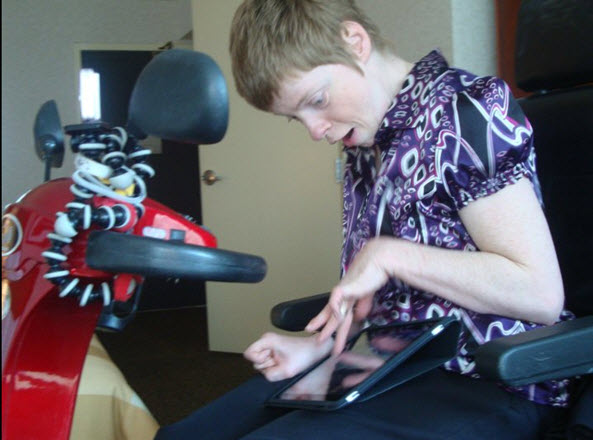
(Photo credit: Karen Putz)
Later that evening I attended the Social Media Club event. Again, the iPad proved useful for communicating. And, even later at the bar, hanging out with Ben Curnett, George Krueger and Mary-Lynn Foster and others.
Mary-Lynn and I were having quite a conversation. Because of the iPad’s back light and clear display, we had no trouble using or reading the iPad in the dimly lit bar. The font size in the Proloque2Go app was also large enough to read from a comfortable distance.
The really cool thing was, because the Holiday Inn and bar had WiFi, I had internet access. When Mary-Lynn asked what I had been up to and I responded problogging and ghost writing, I was able to go to the dotgov blog to show her what I had written. I also showed her the video of me ziplining. The iPad allowed for another level of communication I would not have had with another communicator.
Another night a group of us were at Morton’s Bar and Grill, making plans to go to karaoke, which turned out to be inaccessible but that’s another story. My friend Hope was having trouble figuring out what I was saying and she asked, “Where’s your iPad?†In that moment, I felt a sense of normalcy and acceptance. Using an iPad, which could become as commonplace as the Blackberry and iPhone, is not yet another thing that makes me different. I wasn’t using a strange, unfamiliar device to communicate with this group. People were drawn to it because it was a “recognized†or “known†piece of technology rather than being standoff-ish with an unknown communication device.
I liked how as soon as I turned it on and slid the lock, the thing was ready to go. There’s no need to wait for it to boot or for programs to start; the apps start immediately. Although there were a few times when the iPad appeared unresponsive, even when others tried it. I found restarting fixed that; perhaps there’s another trick when that happens that I have yet to discover.
Initially I held that iPad in the landscaped position on my lap, giving me the largest size of keyboard. This way I was able to steady my hand against my abdomen and type with more than only my left thumb, which was a novel concept. And, at times, the screen would spin around and I would need to type upside down until I figured out to spin the screen back. A way to turn down the spinning sensitivity would be great.
Typing accuracy wasn’t perfect; I was discouraged and having second-thoughts about my purchase. But, a few days ago I realized my typing wasn’t perfect on my old Smith Corona typewriter with keyboard or on my various computer keyboards, erasing my doubts about my purchase decision.
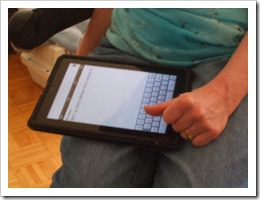 While killing six hours at the O’Hare airport, I discovered that holding the iPad in the portrait position yet sideways on my lap with the small-sized keyboard parallel with my thigh, I could guide my hand along my thigh and type with my left thumb. My typing speed and accuracy was surprising; I’m curious to test if my typing speed is any faster on the iPad – that’s another post. Although I do envision myself sitting out on the deck, on the couch or comfy in bed, writing.
While killing six hours at the O’Hare airport, I discovered that holding the iPad in the portrait position yet sideways on my lap with the small-sized keyboard parallel with my thigh, I could guide my hand along my thigh and type with my left thumb. My typing speed and accuracy was surprising; I’m curious to test if my typing speed is any faster on the iPad – that’s another post. Although I do envision myself sitting out on the deck, on the couch or comfy in bed, writing.
Then, I did something I had never done before: I went into one of the many Starbucks at O’Hare and ordered my first mocha frappuccino by myself. No misunderstanding or hand gesturing involved. It was so cool, like another door had just opened for me!
I feel like technology is finally catching up with what I truly need.
To keep up with my adventures, musings and insights, sign up to receive my future posts via email.
If you enjoyed this post, consider buying me a chai tea latte. Thanks kindly.
 I’ll also have my trusted, low tech alphabet card with me…just in case!
I’ll also have my trusted, low tech alphabet card with me…just in case!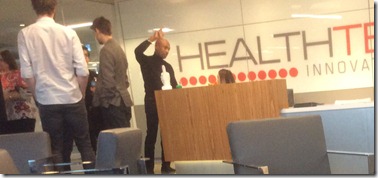
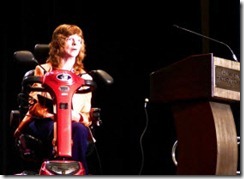 As I mentioned in an email to Lynda, I am not looking for a miraculous cure, to be walking straight and talking clearly. But, what if some improved functioning is possible? What if more controlled movement is possible? What if I could
As I mentioned in an email to Lynda, I am not looking for a miraculous cure, to be walking straight and talking clearly. But, what if some improved functioning is possible? What if more controlled movement is possible? What if I could 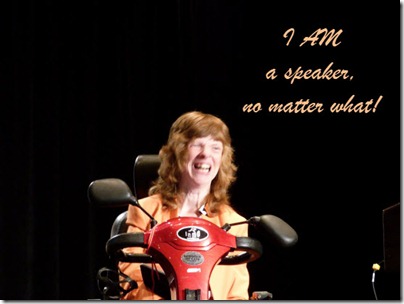
 Subscribe via RSS
Subscribe via RSS



